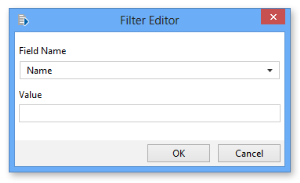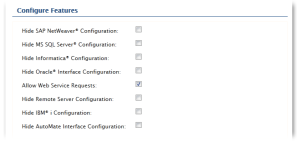 Automate Schedule - List agents
Automate Schedule - List agents
Declaration
<AMSKYBOT ACTIVITY="list_agent" SESSION="text" IP="text" PORT="number" USERNAME="text" PASSWORD="text (encrypted)" HTTPS="YES/NO" PROXYTYPE="text (options)" PROXYSERVER="text" PROXYPORT="number" PROXYUSERNAME="text" PROXYPASSWORD="text (encrypted)" RESULTDATASET="text" VARBINDNAMES="text (options)" VARBINDVALUES="text" />
Description
Retrieves a list of agents matching the filter parameters specified (if any) and populates a dataset with the name of each agent.
Practical usage
Used to retrieve a list of agents in order to perform other Automate Schedule activities on them during subsequent steps.
Parameters
Connection
| Property | Type | Required | Default | Markup | Description |
|---|---|---|---|---|---|
| Connection | --- | --- | --- | --- | Indicates
where this activity's Automate Schedule credentials should originate from.
The available options are:
NOTE: This parameter does not contain markup and is only displayed in visual mode for task construction and configuration purposes. |
Connection - Session
| Property | Type | Required | Default | Markup | Description |
|---|---|---|---|---|---|
| Session | Text | Yes, if Connection is set to Session | Automate ScheduleSession1 | SESSION="Session1" | The name of the session to associate this activity with. This parameter is active only if the Connection parameter is set to Session. If the Connection parameter is set to Host, this parameter is ignored and the remainder of the parameters specified below becomes active. |
Connection - Host > Credentials
| Property | Type | Required | Default | Markup | Description |
|---|---|---|---|---|---|
| Server | Number/Text | Yes | (Empty) | IP="xxx.xxx.xxx.xxx" | The Domain Name System (DNS) name (for example, www.domain.com) or IP address (for example, xxx.xxx.xxx.xxx ) of the Automate Schedule Server of where to establish communication. |
| Port | Number | Yes | (Empty) | PORT="0880" | The TCP/IP port assigned to enable communication with the Automate Schedule server. |
| User name | Text | No | (Empty) | USERNAME="jdoe" | A
valid username of a user configured to access the Automate Schedule
Server. NOTE: Certain Automate Schedule activities
may or may not be permitted depending on the permissions set for
the user. |
| Password | Text | No | (Empty) | PASSWORD="text (encrypted)" | The correct password for the user entered above. |
| Session | Text | Yes | (Empty) | SESSION="SkySession" | The name of the session to use to link to other Automate Schedule activities. |
| Use Https | Yes/No | No | No | HTTPS="YES" | If selected, specifies that the server protocol type is HTTPS (secure HTTP). If disabled, the server protocol type is HTTP. This parameter is disabled by default. |
Connection - Host > Proxy
| Property | Type | Required | Default | Markup | Description |
|---|---|---|---|---|---|
| Proxy type | Text (options) | No | Default |
|
The
type of proxy required for Automate Schedule connections that pass through
a proxy server. The available options are:
|
| Use authentication | --- | --- | --- | --- | If
enabled, indicates that proxy authentication is implemented. This parameter is active only if the Proxy
type parameter is set to HTTP. NOTE: This parameter does not contain markup and is only displayed in visual mode for task construction and configuration purposes. |
| Proxy server | Text | No | (Empty) | PROXYSERVER="proxy.host.com" | The hostname (server.domain.com) or IP address (xxx.xxx.xxx.xxx) of the proxy server. This parameter is available only if the Proxy type parameter is set to HTTP. |
| Proxy username | Text | No | (Empty) | PROXYUSERNAME="ProxyUser" | The proxy username to use to authenticate and establish the connection. This parameter is available only if the Use authentication parameter is enabled. |
| Proxy password | Text | No | (Empty) | PROXYPASSWORD="encrypted" | The proxy password to use to authenticate and establish the connection. This parameter is available only if the Use authentication parameter is enabled. |
| Proxy port | Number | No | 8008 | PROXYPORT="8008" | The port to use to connect to the proxy server. This parameter is available only if the Proxy type parameter is set to HTTP. The default value is 8008. |
Agent
| Property | Type | Required | Default | Markup | Description |
|---|---|---|---|---|---|
| Create and populate dataset with agents | Text | Yes | (Empty) | RESULTDATASET="agentsList" | The name of the dataset to create and populate with the list of agents. See Datasets for more information. |
Filter
| Property | Type | Required | Default | Markup | Description |
|---|---|---|---|---|---|
| Field name | Text | No | (Empty) | VARBINDNAMES="theFieldName" | The field name to associate with the value entered under the Field value parameter. This enables filters to be set by way of name/value pair. See Filters for more information. |
| Field value | Text | No | (Empty) | VARBINDVALUES="theValue" | The field value that should match the field name selected under the Field name parameter. This enables filters to be set by way of name/value pair. See Filters for more information. |
Additional notes
Datasets
A dataset is a multiple column, multiple row container object. This activity creates and populates a dataset containing a specific field in addition to the standard dataset fields. The table below describes this field (assuming the dataset name assigned was (theDataset).
| Name | Type | Return Value |
|---|---|---|
| theDataset.agentname | Text | Returns the assigned name of the agent. |
Filters
This activity features a filtering mechanism designed to examine each output request for certain qualifying criteria. You determine which objects to filter by way of name/value pair, whereby, only objects with values matching the field name you specify will qualify.
Adding a Filter
-
Click the Add button. A Filter Editor dialog appears (as shown below).
-
In the Field Name parameter, click the drop-down arrow and select from the available fields in which to filter. Note that field names vary depending on the activity.
-
In the Value parameter, enter a value that should match the selected field name.
-
Click OK when finished.
Editing a Filter
- Select a Field Name/Value pair listed under the Filter property.
- Click the Edit button to open the Filter Editor dialog.
- Make appropriate changes then click OK when finished.
Deleting a Filter
- Select a Field Name/Value pair listed under the Filter property.
- Click the Remove button to permanently delete the filter.
Enabling Automate Schedule Web Service
By default, Automate Schedule has the web services option disabled. This will prevent Automate Schedule actions from running. To enable the Automate Schedule Web Service, log into Automate Schedule's UI and select from the main menu Admin > System Settings. Scroll down to the Configure Features section and select EDIT. Select Allow Web Service Requests (as shown below) and save the settings.
Example
- Copy and paste the sample AML code below directly into the Task Builder Steps Panel.
- To successfully run the sample code, update parameters containing user credentials, files, file paths, or other information specific to the task to match your environment.
Description
This sample task demonstrates use of sessions and loop operations as well as the List agents and Hold agent queue activities:
-
A Create session activity creates and starts a Automate Schedule session in which subsequent Automate Schedule steps can link to.
-
A List agents activity retrieves all agents and places their names in a dataset.
-
A Loop dataset activity loops through the dataset.
-
During each iteration, a Hold agent queue activity performs a hold on the next agent on the list.
-
An End loop activity ends the loop operation.
-
An End session activity ends the current session.
<AMSKYBOT SESSION="Skybot_1" IP="10.0.1.69" PORT="8008" USERNAME="admin" PASSWORD="AM4xbZm+mwQN5MGOCNMiHvJ5srNQYnFndV8aME" />
<AMSKYBOT ACTIVITY="list_agent" SESSION="Skybot_1" RESULTDATASET="theAgent" />
<AMLOOP ACTIVITY="dataset" DATASET="theAgent"><AMSKYBOT ACTIVITY="hold_agent_queue" SESSION="Skybot_1" AGENTNAME="%theAgent.AgentName%" /></AMLOOP>
<AMSKYBOT ACTIVITY="hold_agent_queue" SESSION="Skybot_1" AGENTNAME="%theAgent.AgentName%" />
<AMLOOP ACTIVITY="end" />
<AMSKYBOT ACTIVITY="close_skybot" SESSION="Skybot_1" />

